
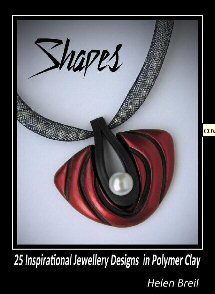
Shapes
This is a worthwhile buy. It is full of ideas with excellent photographs in full colour, clearly presenting the multitude of ideas and patterns. It will result in you spending hours producing beautiful work if you follow her very clear explanations. It is good value too for being an e-book you can go off at tangents to other pages – 180 pages of beautifully coloured tutorials.
This is a worthwhile buy. It is full of ideas with excellent photographs in full colour, clearly presenting the multitude of ideas and patterns. It will result in you spending hours producing beautiful work if you follow her very clear explanations. It is good value too for being an e-book you can go off at tangents to other pages – 180 pages of beautifully coloured tutorials.

Polymer Clay Bracelets
This is a beautifully presented book with organised tutorials, in German on the left of the pages and in German on the right (great if you are learning German!) An original idea. And it also has some first class photographs. But I was disappointed – the content was sparse. There are the usual first few pages with tools and equipment and some basic techniques to follow. Then there are a number of tutorials on how to make bracelets. If you like very unusual ones, then this is for you. But I think I expected to learn more.
This is a beautifully presented book with organised tutorials, in German on the left of the pages and in German on the right (great if you are learning German!) An original idea. And it also has some first class photographs. But I was disappointed – the content was sparse. There are the usual first few pages with tools and equipment and some basic techniques to follow. Then there are a number of tutorials on how to make bracelets. If you like very unusual ones, then this is for you. But I think I expected to learn more.
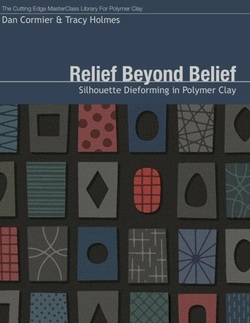
Relief Beyond Belief
Dan Cormier is precise, and his book is the same. It is carefully organised and one can jump from area to area which is the advantage of an on line book. The organisation is extreme, however, as his directions to pages seem to take up unnecessary space. What he has to say is meticulous and with excellent diagrams and photographs. He concentrates on one project only, in fine detail. If detail is what you want then you will like this book but unless you have his special templates the book is actually not much use to you!
Dan Cormier is precise, and his book is the same. It is carefully organised and one can jump from area to area which is the advantage of an on line book. The organisation is extreme, however, as his directions to pages seem to take up unnecessary space. What he has to say is meticulous and with excellent diagrams and photographs. He concentrates on one project only, in fine detail. If detail is what you want then you will like this book but unless you have his special templates the book is actually not much use to you!
If you have any books you would like to recommend please do send details to book(at)clayaround.com (substitue the @) and we will put up your recommendations onto the site.
The Art and Craft of Poymer clay by Sue Heaser (2007)
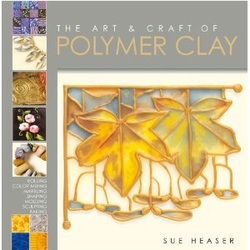
Sue has written many books and this is one of the more recent ones (albeit a number of years old) which is very comprehensive - ideal for those new to Polymer clay. Sue is another teacher who is very generous with her knowledge and this book covers a vast range of techniques with quality illustrations, hints and tips and ideas for development. If you want a first book, this would be one to be considered.
How to Make polymer clay beads - sep-by-step techniques for creating beautiful ornamental beads by Carol Blackburn (2007)

Carol is as generous in her teaching in this book as she is when one meets her. She gives away so many tips and tricks and offers comprehensive tutorials on so many polymer clay techniques. When asked which is one of the best books to start with when coming new to polymer clay, this has to be the recommendation. The images are not calculated to be elegant - they are utilitarian. About the only criticism on offer is that the type is very small - but that way she crams in so much more information. An important book in your polymer clay library.
Patterns in Polymer - Imprint and Accent Bead Techniques by Julie Picarello (2011)
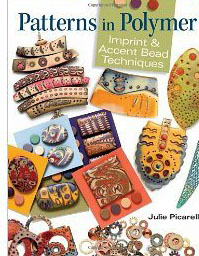
This really is a great book - she gives away the secret of her signature 'jecru' blend - those quite wonderful soft colour blends she uses in virtually all her work. The book is all about her slant on mokome gane and she makes it look so easy, with many colourful images and ideas, hints and tips, and palettes. This really is a must book if you enjoy colour and creativity
The complete bnook of Polymer Clay by Lisa Pavelka (2010)

Lisa said herself that there is no such thing as a complete book of polymer clay, but she certainly has a try. Lisa is another of the polymer clay teachers who gives what she knows generously. To be fair she never stops promoting her own products and they figure in this book, but there is much to be learned from it, and I would recommend it to beginners and experts alike. There is a lot of text which might be off putting, but most is worth reading and the tutorials are thorough with lots of tips and tricks.
The art of polymer clay millefiori techniques by Donna Kato (2008)
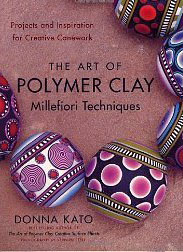
This book has lots of ideas and lots of techniques and is useful for beginners - although some of the tutorials are somewhat obscure and need to be read through more than once. You need to be a fan of Donna Kato's distinctive style to really appreciate some of the projects however. The images are clear and the gallery pictures show Donna's skill as a clayer.
The section on colour is written by Laurie MacIsaac with Donna arguing that her colour choices are more instinctive than academic. It is a useful section. This is another book that is useful to have on your Polymer Clay bookshelf
The Art of Polymer Clay Creative Surface Effects by Donna Kato ((2007)
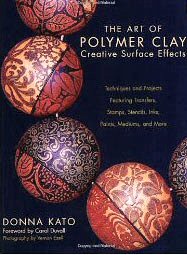
This is a companion to Donna's book on millefiori techniques and produced a year before the other book so they are in the same style. The images are similar, the tutorial too. This book emphasises more than her other, Donna's distinctive way of producing artifacts, although along the way she does suggest some really interesting surface ideas.
It is interesting that like so many artists, her tutorials on Mica shift use gold - I guess it is the colour that shows this technique up welll. This is not such a useful Donna book but one still worth considering.
Creative Canes 30+ cane tehciques with Polymer Clay by Barbara McGuire (2007)
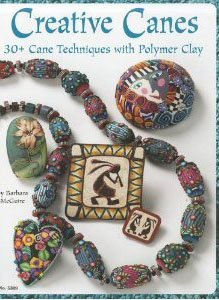
This thin book (only 35 pages) really does give ideas if you are into caning. From basic bull's eye canes to stripes, bargello and chevron, from leaves and petals to face canes - what ever your level of expertise there is something for you. She packs a lot into these few pages with many images and no space wasted.
Clay Characters for Kids by Maureen Carlson (2003)
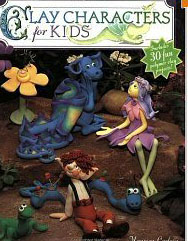
Well I for one haven't worked out how to do sculpture - so this is a book for me! Marketed for children it nevertheless teaches basics on shape, proportion and creating faces. It is colourful, and has simple progressive tutorials with lots of lovable characters to create. Trundle the turtle easily becomes a frog, baby bears take on all sorts of personalities as does Rainbow Goblin . This is one of many books by Maureen Carlson whose expertise in sculpture is to be explored.
The Art of Jewelry Polymer Clay Techniques Projects Inspiration by Katherine Duncan Aimone (2006)
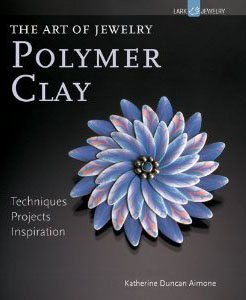
This is a clever book for what the author has done is asked well known polymer clay artists to give you an insight into single projects that they have undertaken. Names such as Judith Skinner, Sandra McCaw, Lindly Haunani and Jeffrey Lloyd Dever are amongst the names. It is well presented with excellent illustrations and gallery pictures. If you like specific projects then this is the book for you.
Enlightened Polymer Clay - Artisan Jewelry Designs Inspired by Nature by Rie Nagumo (2006)
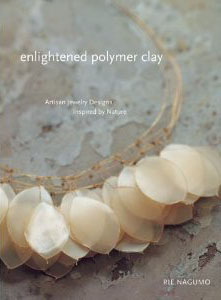
On first look you would think this is simply a book of stunning photographic images - up to page 35 it is nothing but that. But then it goes onto the tutorials which are all words and drawings and clearly set out. It makes one realise how simple designs can be effective - and of course how simple designs can attract when photographed well. Unusually, the list of tools is at the end of the book.
Creative stamping in polymer clay - 24 unique projects by Barbara McGuire (2002)
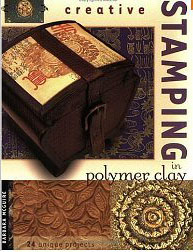
This is not a new book but still has its place in one's library. Barbara McGuire has made it her business to learn about stamping - primarily because she sells a range of her own stamps. First impressions the book seems to be all browns and golds but there is a lot of page space which makes for easy reading. The instructions are clear but the additional tips are in minute type - barely readable. Why do these authors do this? So if you buy this book get your magnifying glasses out....
Mixed Media Mosaics - Techniques and projects using Polymer Clay tiles, beads and other embellishments by Laurie Mika (2007)

When I wrote this review this was a expensive book £54.61 on Amazon), but it has such a plethera of information and is so well presented that it may well be worth buying. It isn't just about mosaics, it is more about developing skills as the book goes on and thus enabling the production of quite stunning work.
Amazon offered it for the Kindle at less than £5 and I bought it - but it really is virtually impossible to follow the tutorials if, like me, you have an ancient Kindle! You do need to see the lovely layout and the friendly text by Laurie
Colour Inspirations - techniques and jewelry projects for creating successful palettes by Lindly Haunani and Maggie Maggio (2009)
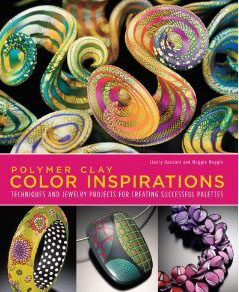
You need to have an academic mind to understand a lot of this book - the concepts are complex and the exercises time consuming. If you are 'in to' colour mixing then this is certainly the definitive book for polymer clayers. Lindly and Maggie now have a reputation for being the foremost experts in this field in the polymer clay field. The images are excellent, the colours superb, and the font small but readable. Look at it before buying it for some may be daunted!
Poymer Clay beads by Grant Diffendaffer (1979)
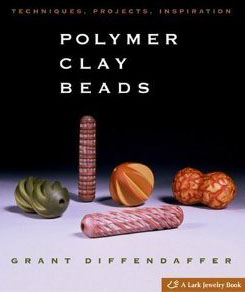
This book was ahead of its time with quality illustrations and explicit tutorials. However Grant concentrates on the more extra ordinary things you can do with beads - in particular carving, moulding,and turning the clay - it certainly opens one's eyes to the possibilities and if you can get hold of what was once a very expensive book at the time (well over £20) it is worth buying (found on Amazon for £4!).
Polymer clay Mosaics - 15 artistic projects by Sue Heaser (2003)

The presentation of the book is, at first sight, outdated, but the content is not. Sue, as ever, generously offers, in great detail, the benefit of her skills. She particularly showcases her skill with Pietre Dure - work which does immaculately. She shows you that there are so many possibilities doing nothing more than mosaics.
Creating Lifelike Figures in Polymer Clay - Tools and Techniques for Sculpting Realistic Figures by Katherine Dewey (2008)
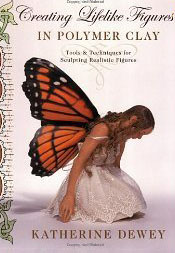
If you want to learn about sculpting in Polymer clay then you really will find this book useful. It goes into anatomy just sufficiently to be understood without being too 'heavy' and the illustrations are quite excellent. The tools to use are explained extensively too. The cover does not do it justice - it is not just fairies! It is a book with enough detail for you to have it open by your side constantly as you learn to sculpt in polymer clay. If this is your interest, this is your book.
Amazing Clay Flowers - Creating Realistic Flowers and Flral Arrangements by Norika Kawaguchi (2008)
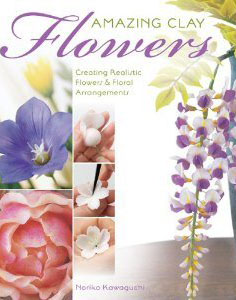
And they truly are amazing clay flowers. However - you need to make some adjustment if you choose this book because the clay she uses is actually using resin clay. However, one can adapt using polymer clay as long as you use one of the firm clays such as Kato, Pardo Professional Art Clay or even Fimo Classic. The tutorials are good although most of them are black and white photos which is a little disappointing. However, there are some truly beautiful possibilities in this book
Polymr Clay Bears by Birdy Heywood (2010)
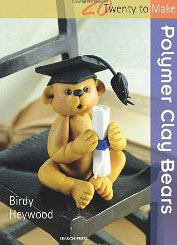
This little book is only 15.5cm x 21.5cm and has 48 pages - and is available on Amazon for less than £4 - so it won't break the bank and will give you a lot of fun. It is so simple because she has a basic template for proportions and then simply adapts the basic bear to lots of personalities. Birdy is a talented polymer clay sculptor who has applied her skills and imagination in this delightful book.
Faux Surfaces in Polymer Clay by Irene Semanchuk Dean (2005)

This whole book is about imitating precious stones, metals and wood - from pewter to mother of pearl (not a good tutorial - it didn't work for me) and from rusted steel (I suppose it does have some applications...) to Agate. There are some original ideas and if you haven't tried creating faux stones then it is a useful book. The images are good and the instructions are clear.
Making Jewelry from Polymer Clay by Sophie Arzalier (2010)
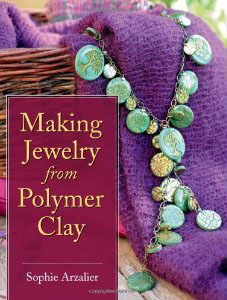
The full page images are striking and the title themes in the book are 'looks': from beach to bohemian. She is very organised offering sections on textures, materials, canes and techniques as well as the usual introduction to polymer clay itself. There is a lot of information, and there are a lot of techniques and many ideas one could expand on. Her tips are in the form of 'advice' which is different - but all advice is useful. It is a nicely published book which is a pleasure to hold.
